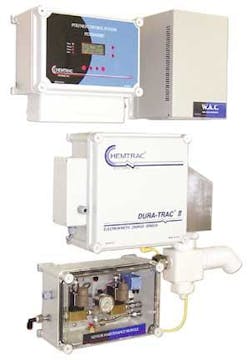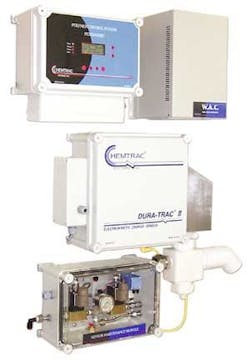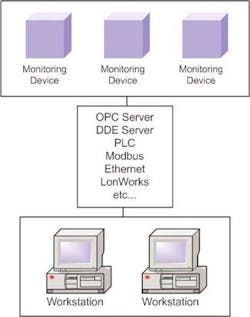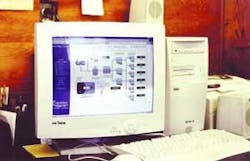Automation Yields Improved Water Quality, Process Security
By Scott Bickle
The basic chemistry and mechanics of operating water and wastewater plants hasn't changed much over the last 25 years. What has changed is instrumentation, control systems, and data processing. The exponential advancement of digital signal processing and increased computer speed has made it difficult for designers, manufacturers, and system integrators to select the best system. The following is a brief synopsis of where we were, how we got to where we are, and what the future holds for water process automation.
From stand-alone systems with proprietary software to wireless web-based solutions, methods of controlling and monitoring through software have evolved over the years. Though many of the early methods of collecting data through software are still widely used, they are not always convenient as the protocols are often unique to the equipment.
It was usually up to the consulting engineers to decide the best option for using software in their plant automation, while it was up to the manufacturer to decide the best technology to offer. This caused a problem for both the end user and the developer as the same protocol was not always available for all units in the process. In the early years, the manufacturer of process automation equipment would use its own proprietary software. This usually limited how the equipment could communicate as the technology was still young and accepted protocols had yet to be developed.
Over the past 20 years PLCs, digital and paper chart recorders, PC Cards and various other types of solutions were developed and used to collect, display and store process data, but it was the advancement of computers that helped drive the development of new protocols. SCADA packages that allow many different types of protocols to communicate with the same client software were developed.
For example, Modbus was and still is commonly used in plant automation for communication with PLCs and SCADA systems. Modbus has been convenient as it has allowed the manufacturer to provide equipment with a protocol that any systems integrator could use to develop their own software or driver. This type of technology was a way for plants to tie all equipment to a central controller where process data could be collected and provided to a recorder or control room computer.
Another technological achievement in the 1980s was the development of new protocols that different development packages could use to collect data through software. These industry standard protocols, such as DDE, could be used by developers to create software drivers for their equipment. These drivers could then be used by integrators to bring data to their SCADA systems, thus eliminating the need to develop a driver themselves.
This made it easier for the systems integrator to tie the data tags to charts, data points, and historical logs, but it did require the need to know how to define those tags. These tag definitions were provided by the manufacturer in documentation which could sometimes makes things difficult if the definitions were lost or if many tags needed to be defined.
A few years later another software driver, similar to DDE, was developed to eliminate this problem. OPC or OLE for Process Control was created with the idea of allowing item tags to be defined by the manufacturer and provided in a group directory format. These grouped tags could then be browsed and selected by a client system without having to know how those tags were defined. OPC provided ease of use, but developing the server could be difficult as it required knowledge of some advanced programming techniques.
In the last decade, computer networks rapidly became more important in plant automation as price and ease of operation allowed plant operators and engineers the ability to collect and monitor process data remotely. With software drivers or servers, such as DDE and OPC, water plants could collect vital data remotely and then view the results over the network.
Today
With the development of new programming languages, the Internet is being used to monitor and display process data. This was initially cumbersome and visually unappealing as connection speeds were slow and programming languages were not entirely accepted by all of the standard internet browsers.
As JAVA and XML becomes more widely used by internet developers and with the popularity of the internet increasing, new ideas for monitoring are a reality. Solutions are being created that use new communication protocols (Lonworks) and industrial PC's (Web Servers) to control and display automation data using standard web browsers. These applications, when placed on a network or on the internet, can be accessed by any plant employee with proper password security.
Web pages are being created with charts, visual controls, and data display to allow the user to monitor in a familiar environment. Using a browser is convenient as data tags are already configured and security for individual items and pages can be controlled by the administrator.
As connection speeds increase and component prices decrease, demand for remote monitoring is becoming more and more apparent. With the ability to access remote data as well as live video through corporate networks or over the internet, a new technology has emerged that eliminates many of the headaches of sending data over long distances. Wireless networking components allow network users to place ethernet capable equipment in almost any location while still having access to the data in the control room.
Creative placement of wireless stations makes it possible to send data over long distances. Previously, if an unmanned station needed to be monitored, it was difficult to get the data from the process without sending an operator to the location. Today a wireless station, web camera, and remote networking equipment provide unmanned plant monitoring 24 hours a day.
Using a web server is not limited to the entire process. More and more equipment is now capable of acting as its own web server. This allows operators to easily check the status of an individual piece of equipment using a cell phone, PDA, or wireless web tablet. With the advancement of new technologies, it is now possible for automation equipment to be connected, and process data be viewed immediately from almost anywhere on the planet.
The Future
It would not be unreasonable to think that in the near future monitoring equipment would allow operators to accomplish much more than is already possible. New technologies such as remote control devices, mobile PC tablets, and full color digital phones already exist and could shape the future in process control and automation.
Making everything mobile and wireless seems to be the trend these days, and it may not be long before every operator or engineer would be carrying a PC Tablet around for remote monitoring and control of their process. PC Tablets are similar to PDA's or web tablets, but the next generation may replace notebooks as a solution for mobile computing. Along with remote control devices it will be possible to change process settings and view live data with nothing more than a mobile unit that could be worn on a belt or attached to the equipment itself. As technology continues to decrease in price it may also be possible to use live digital photography or video to monitor water quality and other process changes.
At this point it is difficult to say which device or solution will be the most logical, but it is almost certain that many of these new ideas will be tested and implemented in plants around the world.
About the Author: Scott Bickle is a Software Engineer at Chemtrac Systems, a manufacturer of water and wastewater monitoring, control, and web enabled equipment.



